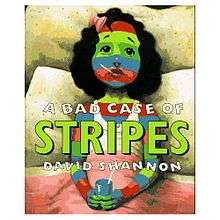A Bad Case of Stripes
 Cover of book | |
| Author | David Shannon |
|---|---|
| Illustrator | David Shannon |
| Country | United States of America |
| Language | English |
| Genre | Children's literature |
| Published | 1998 |
| Publisher | Blue Sky Press (Scholastic Press) |
| Pages | 32 (unpaginated) |
A Bad Case of Stripes is a children's book by David Shannon published in 1998 by Blue Sky Press, a division of Scholastic Press.
Plot summary
The main character is a girl named Camilla Cream who loves lima beans but doesn't want to eat them because her friends dislike them and she wants to be just like them.
One day she wakes up to discover thick, solid-colored stripes on her body. Dr. Bumble determines that Camilla is well enough to attend school. At school the other children tease her and call out colors and patterns which cause the colors on her skin to transform accordingly. The school teachers, worried that her condition may be contagious, send her home.
At home, Camilla goes through a number of increasingly preposterous transformations - turning into a pill after being given some by the specialist doctors, having viruses, bacteria and fungus colonies grow on her body after the community's expert scientists discuss these as a possible cause while examining her, growing roots, berries, crystals, feathers, and a long furry tail after receiving all kinds of cures from all kinds of environmental workers, and transforming into her room after a spiritual counselor says a prayer for her.
Finally, an old lady persuades her to eat some lima beans. Camilla is afraid to admit her willingness to eat them at first, but after realizing that this could be her only hope to being cured, she allows the old woman to feed her them. Camilla is successfully transformed back into a normal being, and with everything back to normal Camilla continues to eat lima beans, and, although her friends consider her strange for liking them, enjoys being different.
Themes
A Bad Case of Stripes discusses ethics and metaphysics,[1] by highlighting self-perception, identity, peer-pressure, and bullying.[2] [3]
Reception
Kirkus Reviews found that "Shannon's story is a good poke in the eye of conformity--imaginative, vibrant, and at times good and spooky--and his emphatic, vivid artwork keeps perfect pace with the tale."[4] Another review said "This imaginative storyline expresses interesting aspects of peer pressure and self-esteem." and "Shannon's colored illustrations are vibrant and animated, and they show a particular talent for vividly portraying facial expressions."[5]
A 2004 study found that it was a common read-aloud book for fourth-graders in schools in San Diego County, California[6] while based on a 2007 online poll, the National Education Association named the book one of its "Teachers' Top 100 Books for Children."[7]
References
- ↑ "A Bad Case Of Stripes". www.washington.edu. University of Washington Center for Philosophy for Children. 2013. Retrieved 6 June 2015.
- ↑ Jo Fletcher. "A Bad Case of Stripes". www.teachingchildrenphilosophy.org. Teaching Children Philosophy. Retrieved 6 June 2015.
- ↑ Ann Kessler. "A Bad Case Of Stripes Lesson Plan" (PDF). www.illinois.edu. University of Illinois at Urbana–Champaign. Retrieved 6 June 2015.
- ↑ "A Bad Case of Stripes". www.kirkusreviews.com. Kirkus Media LLC. 15 December 1997. Retrieved 5 June 2015.
- ↑ Sandra L. Tidwell (April 1999). "A Bad Case of Stripes [book review]". www.trove.nla.gov.au. Farnsworth Juvenile Literature Library, Harold B. Lee Library, Brigham Young University. Retrieved 6 June 2015.
- ↑ Fisher, Douglas; et al. (2004). "Interactive Read-Alouds: Is There a Common Set of Implementation Practices?" (PDF). The Reading Teacher. 58 (1): 8–17. doi:10.1598/RT.58.1.1. Archived from the original (PDF) on December 7, 2013. Retrieved August 19, 2012.
- ↑ National Education Association (2007). "Teachers' Top 100 Books for Children". Retrieved August 19, 2012.